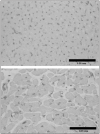Coronary flow reserve in hypertrophic cardiomyopathy: relation with microvascular dysfunction and pathophysiological characteristics
- PMID: 17612685
- PMCID: PMC1896141
- DOI: 10.1007/BF03085982
Coronary flow reserve in hypertrophic cardiomyopathy: relation with microvascular dysfunction and pathophysiological characteristics
Abstract
BACKGROUND.: The decrease in coronary flow reserve (CFR) in hypertrophic cardiomyopathy (HCM) predisposes to myocardial ischaemia, systolic dysfunction and cardiac death. In this study we investigate to which extent haemodynamic, echocardiographic, and histological parameters contribute to the reduction of CFR. METHODS.: In ten HCM patients (mean age 44+/-14 years) and eight heart transplant (HTX) patients (mean age 51+/-6 years) CFR was calculated in the left anterior descending coronary artery. In all subjects haemodynamic, echocardiographic and histological parameters were assessed. The relationship between these variables and CFR was determined using linear regression analysis. RESULTS.: CFR was reduced in HCM compared with HTX patients (1.6+/-0.7 vs. 2.7+/-0.8, p<0.01). An increase in septal thickness (p<0.005), indexed left ventricular (LV) mass (p<0.005), LV end-diastolic pressure (p<0.001), LV outflow tract gradient (p<0.05) and a decrease in arteriolar lumen size (p<0.05) were all related to a reduction in CFR. CONCLUSION.: In HCM patients haemodynamic (LV end-diastolic pressure, LV outflow tract gradient), echocardiographic (indexed LV mass) and histological (% luminal area of the arterioles) changes are responsible for a decrease in CFR. (Neth Heart J 2007;15:209-15.).
Figures




References
-
- Maron BJ. Hypertrophic cardiomyopathy: a systematic review. JAMA 2002;287:1308-20. - PubMed
-
- Maron BJ, Epstein SE, Roberts WC. Hypertrophic cardiomyopathy and transmural myocardial infarction without significant atherosclerosis of extramural coronary arteries. Am J Cardiol 1979;43:1086-102. - PubMed
-
- Koga Y, Yamaguchi R, Ogata M, Kihara K, Toshima H. Decreased coronary vasodilatory capacity in hypertrophic cardiomyopathy determined by split-dose thallium-dipyridamole myocardial scintigraphy. Am J Cardiol 1990;65:1134-9. - PubMed
-
- Camici P, Chiriatti G, Lorenzoni R, Bellina RC, Gistri R, Italiani G, et al. Coronary vasodilatation is impaired in both hypertrophied and non-hypertrophied myocardium of patients with hypertrophic cardiomyopathy: A study with nitrogen-13 ammonia and positron emission tomography. J Am Coll Cardiol 1991;17:879-86. - PubMed
-
- Misawa K, Nitta Y, Matsubara T, Oe K, Kiyama M, Shimizu M, et al. Difference in coronary blood flow dynamics between patients with hypertension and those with hypertrophic cardiomyopathy. Hypertens Res 2002;25:711-6. - PubMed
LinkOut - more resources
Full Text Sources
